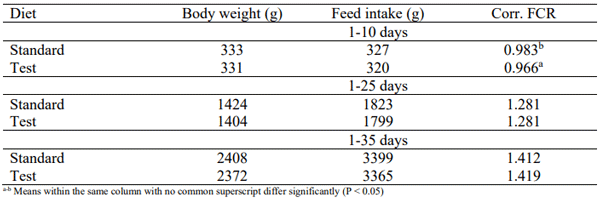I. INTRODUCTION
Phosphorus (P) is a critical nutrient for growth and structural integrity of growing animals. Nutritionists generally tend to use a significant margin of safety while formulating commercial diets to avoid any deficiency symptoms. A large variation appears to exist in P requirement estimates/recommendations for broiler chickens across different sources; e.g. summarizing some selected references, Table 1 shows the highest vs. lowest estimates to differ by 0.8 to 1.3 g/kg available P (AP), or a variance of 20-43 % for a given phase.
Table 1 – Available phosphorus (P) recommendations for straight-run broilers by source
The factors likely to contribute to reported variation include lack of universally accepted definitions of AP (Shastak and Rodehutscord, 2013), variation in the relative bioavailability of P among different sources of inorganic phosphates detailed in Sauvant et al., (2004) and by complex interactions between dietary P, Ca, phytase, and vitamin D3 (Mohammad et al., 1991; Tamim et al., 2004).
II. MATERIALS AND METHODS
Commercial-type broiler diets (maize-soybean meal) were formulated to supply energy and nutrients as per industry practice. The test variable was the dietary AP (and Ca) which was represented as ‘standard’ and ‘test’ plans. The ‘standard’ plans were based on the P/Ca levels currently in use by the commercial industry and were closer to those recommended by the primary breeders (Table 1), while the test plan was based on the recommendations published by Creswell (2012). For the purpose of these studies, non-phytate P (NPP) was used for AP and was defined as the sum of the total P from inorganic phosphate (mono-di-calcium phosphate and mono-calcium phosphate, respectively in trial 1 and 2) and non-phytate P from the remaining constituent ingredients derived from Sauvant et al. (2004). No phytase was used in trial 1 while 1000 FTU of an enhanced Escherichia coli phytase (Quantum Blue – AB Vista UK) formulated with the mineral contribution as per supplier’s matrix (1.95 g/kg AP and 2.15 g/kg Ca) was included in trial 2. In trial 1, feed samples were analyzed for proximate, total P and Ca by Association of Official Agricultural Chemists (AOAC, 2015) methods. Milled sample of test feeds were scanned using a FOSS NIR spectrophotometer for the prediction of phytate-P (Enzyme Services and Consultancy, UK). Dietary NPP was calculated as the difference between total and phytate P. A three-phase feeding program was employed in both trials with feed offered as crumbles (1-10 days post-hatch) and pellets (11 to 42 or 35 days post-hatch in the first and second trial respectively). Each diet was fed to 16 replicates of 30 chicks (Lohman Indian River, Trial 1) and 10 replicates of 20 chicks (Ross 308, Trial 2). Pen feed intake (FI) and body weight (BW) were recorded at the end of every feeding phase, and feed conversion ratio (FCR) corrected for mortality was calculated. In Trial 1, at day 25, two birds (one male and one female) close to the pen average weight from each pen were chosen for the measurement of toe ash. BW, FI, FCR, mortality and toe ash were calculated and subjected to analysis of variance as a randomized complete block design using SPSS. Means were compared using Tukey’s test using P < 0.05 as conventional minimum level of significance.
III. RESULTS AND DISCUSSION
a. Trial 1
Table 2 shows the NPP and Ca levels used in standard and test plans. The test plan resulted in higher feed intake at 10 and 25 days post-hatch and higher body weight at 10 days while no treatment effect was observed for the performance at day 42 post-hatch (Table 3). Toe ash, (total and %) measured at 25 days did not differ across treatments (351 vs. 345 mg or 12.6 vs. 13.0%, respectively for standard and test plans).
Table 2 – Formulated dietary levels of non-phytate phosphorus (NPP) and calcium (Ca), Trial 1
Table 3 - Growth Performance of broilers, Trial 1
b. Trial 2
Table 4 shows the NPP and Ca levels used in standard and test plans. The test plan resulted in better FCR compared with the standard plan at 10 days post-hatch; no treatment effect was observed for the growth performance at 25- or 35-days (Table 5).
Table 4 – Formulated dietary level of non-phytate phosphorus (NPP) and calcium (Ca), Trial 2
Table 5 - Growth Performance of broilers, Trial 2
IV. CONCLUSIONS
Data from the above studies suggest that NPP/Ca level of 4.0/8.0, 3.5/7.0 and 3.0/6.0 g/kg respectively for 1-10, 11-25 and 26-35 or 42 days post-hatch was sufficient to support the optimal growth performance (Trials 1 and 2) and bone mineralization (Trial 1) of commercial broiler.
Presented at the 32th Annual Australian Poultry Science Symposium 2021. For information on the next edition, click here. 












.jpg&w=3840&q=75)